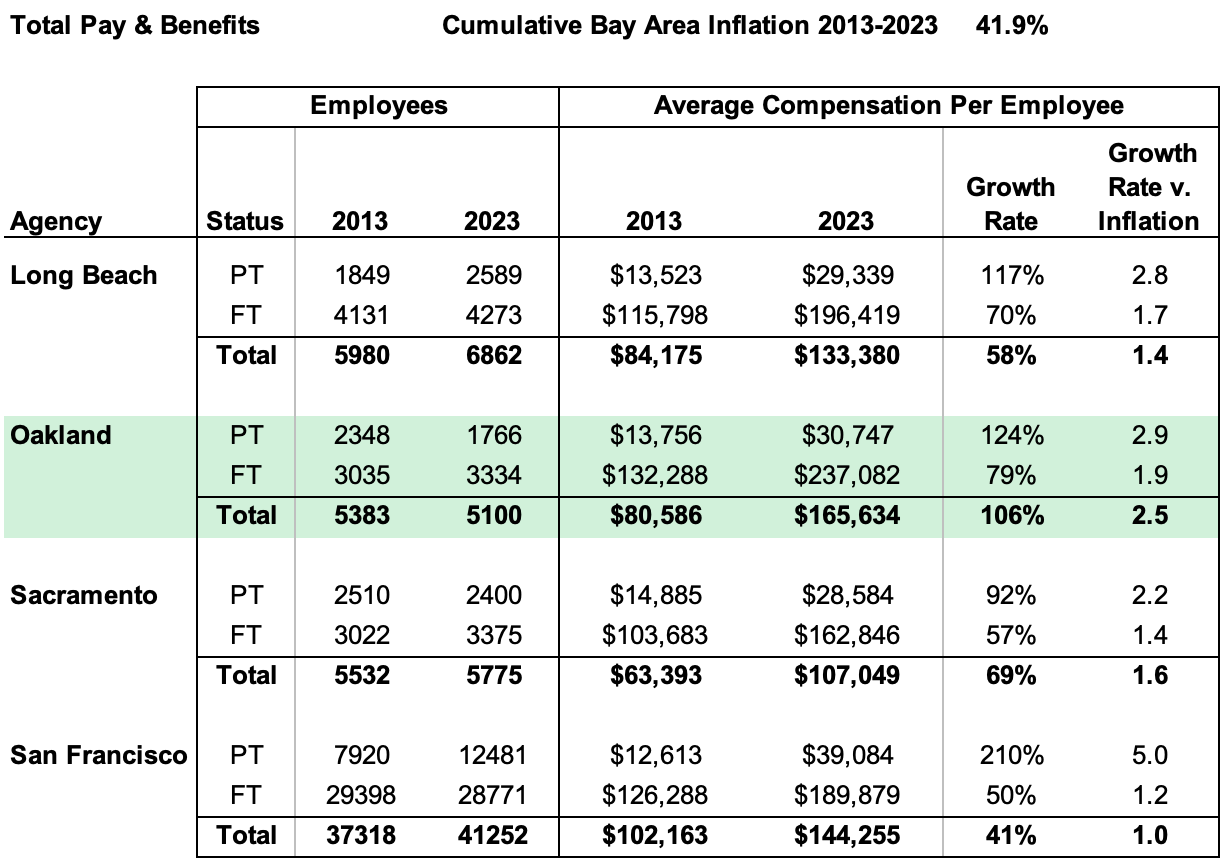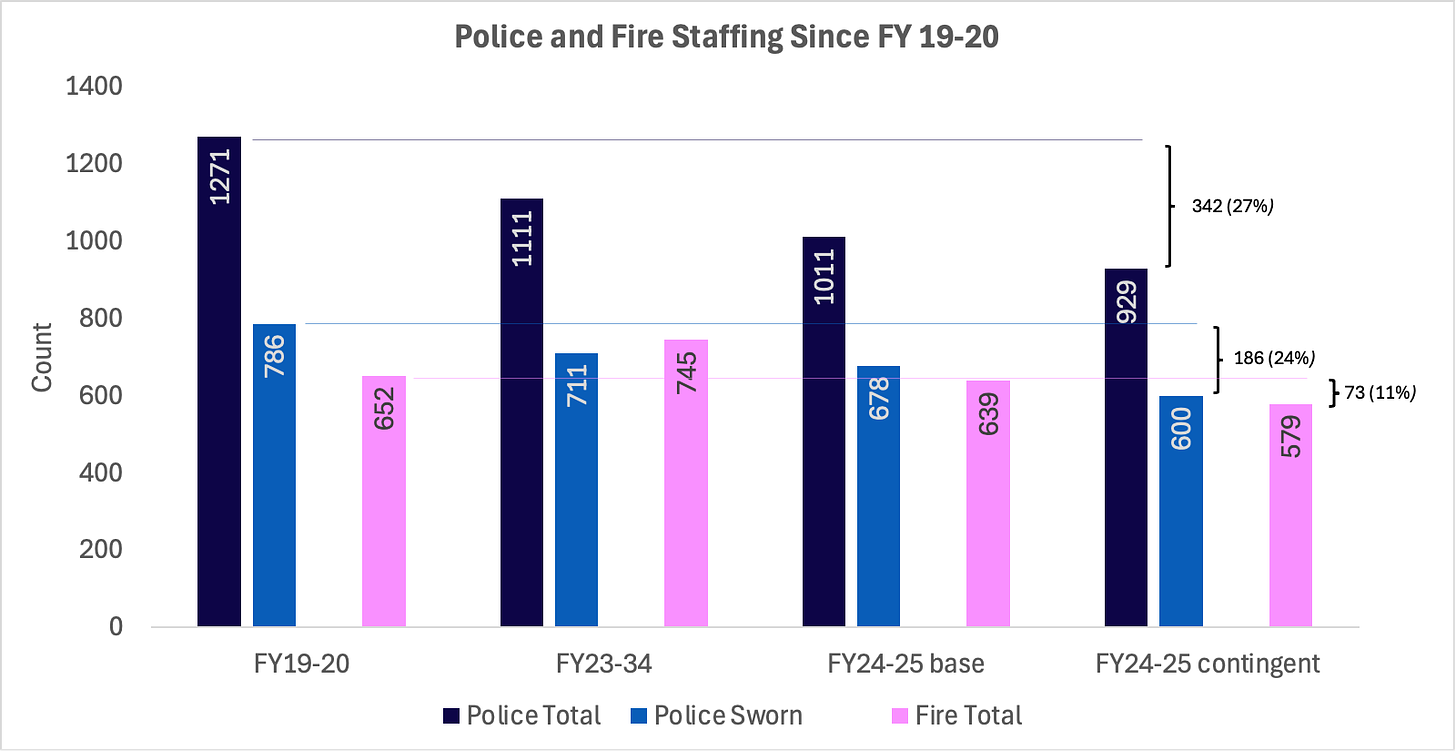Oakland employee compensation grew 2.5 times faster than inflation, far outpacing other cities
Since 2013, Oakland grew employee compensation by $411M. That’s $184M more than needed to keep pace with inflation. It far exceeds raises of other California cities, and precipitated a budget crisis.
Oakland City Council passed Mayor Sheng Thao’s controversial FY24-25 budget on July 2 with five of eight votes (council members Bas, Fife, Kaplan, Kalb, and Jenkins voted ‘aye’).
This budget seeks to close a $175M projected deficit, and head-off a financial crisis that has been anticipated at least since 2021, but was left unaddressed for years. It forced a declaration of “extreme fiscal necessity” by the council, which allows the city to suspend voter-mandated restrictions on the use of ballot measure taxes such as maintaining minimum police staffing and minimum funding for parks and recreation.
Despite the city’s severe fiscal distress, the budget includes substantial pay raises for city employees. Those raises cap off twelve years of compensation increases that added $411M in costs to the city budget since 2013. The raises also exceed inflationary cost of living adjustments (COLA) by $184M.1 Oakland employees are now paid far more than similar-sized California cities as well as San Francisco.
The excess compensation is cratering the city’s ability to deliver essential services, and plunging it into the budget crisis. The city’s new FY24-25 budget slashes police, fire and medical services by 172 positions just two weeks after the worst mass shooting in Oakland’s history.
But those cuts may not be enough. The budget depends on $45M of projected tax revenue increases and $63M from the sale of the Coliseum. Both assumptions are questionable, and the latter is so flimsy that the council also approved a “contingency budget” with additional cuts that kick-in on October 1 if the Coliseum money doesn’t materialize. Combined, the baseline plus contingency cuts will eliminate 310 police and fire positions2 out of a total of 1721. This will potentially reduce sworn officers to 600 through attrition, and brown-out 5 fire engine companies. The budget also postpones construction of an OPD crime lab and a new fire station.
If the contingency plan goes into effect, it will mean a 27% reduction in authorized (non-frozen) police staffing since 2020 (from 1271 to 929), including a 24% reduction in sworn officer positions (from 786 to 600). For point of reference, Oakland would need more than 1000 sworn officers to meet the national per-capita average—and that amount does not account for Oakland’s above average crime rate.
Sacrificing public safety is not the only option
In the budget meetings over the past two weeks, the city administration and council debated the when and how of massive cuts to public safety, as if they were absolutely unavoidable. But they conspicuously avoided discussing the single largest cause of Oakland’s fiscal distress—the unaffordable growth in employee pay and benefits.
Total city compensation expense3 has grown 2.3X faster than inflation since 2013—specifically, total compensation spending has increased by 94.7% from $434M to $845M while Bay Area inflation was 41.9% over the same period.
That additional compensation is not being spent on additional staff. The total staff in Oakland fell by 286 employees during the same period. The money was spent on outsized employee raises. Average employee compensation has grown 2.5X faster than inflation during that period.
Oakland isn’t able to afford these large compensation increases. It has run a large ongoing deficit just to maintain the declining staff count.
If the rate of pay in Oakland increased at the same rate as San Francisco over those 10 years (56% growth), Oakland would have saved $167M in expenses in 2023. That amount is nearly the same as Oakland’s present budget deficit.
Moreover, this calculation does not fully account for the additional 14% in pay raises given to City of Oakland employees between July 2022 and July 2025. The City Administrator estimated they would add $100M to the FY24-25 budget (relative to 2022), of which $10M is for sworn police raises, $12M for sworn fire raises, and $78M for other employees (non public safety). About one third of those raises take effect after 2023, exacerbating the compensation excesses noted above.
Correcting the outsized compensation growth could save public safety jobs and services if it was addressed.
Oakland pays employees more than other cities
In the 8-hour special budget meeting on June 28, employee raises were discussed only once by a council member, when Dan Kalb skirted the issue of compensation for 3 minutes. And in that brief discussion, he alluded to a common justification for the raises—that they are needed to stay competitive with other cities.
But that claim is not supported by California city compensation data. Oakland city employee average compensation exceeds comparable mid-sized California cities and San Francisco, both in absolute amount and growth rate, and is disproportionate to the median household income.
From 2013 to 2023 the average total compensation for full-time city employees rose by 79% to $237K per year. In comparison, Sacramento and Long Beach (both with a similar number of employees to Oakland) the average total compensation per full-time employee rose 57% to $163K per year and 70% to $196K per year, respectively. San Francisco rose 50% to $190K per year.
Oakland not only pays city employees more than neighboring municipalities, it also pays them well beyond the average Oakland resident. In 2023, the average household income (which includes multiple wage earners) for an Oakland resident is $140,000.

The deeper problem is outsized benefit and pension pay
The driver for this excessive pay is not base salaries and wages. It is outsized growth in benefits (including pension). Oakland’s average employee base pay is similar to other medium sized cities in California (normalized for local cost of living) and lower than that for San Francisco. Oakland’s average benefits (including pension) per full-time employee adds 72% on top of base pay. In comparison, Long Beach, Sacramento, and San Francisco benefits add 41%, 31% and 33% on top of base pay, respectively.
In short, Oakland pays twice as much in benefits as comparable cities.
Overall, Oakland’s benefit costs have increased 140% over 10 years. Meanwhile San Francisco benefit costs only increased by 39% and Sacramento by 25%.
Benefits are not the only perk unique to Oakland employees. The city pays an average of $13K in “other” pay per full time employee. Other pay includes car allowances, meal allowances, relocation and other personal expense compensation. By contrast, San Francisco pays $6K in other pay on average, Long Beach pays $3K, and Sacramento pays $2K.
It’s time to face the problem
Following the 2008 financial crisis most Oakland employee unions agreed to compensation cuts in pay to avoid layoffs. In the years following, the City more than restored those cuts, overcorrecting to the point where the lives and livelihoods of half a million Oakland residents are being placed at risk to sustain disproportionate pay of a few thousand city workers.
If Oakland’s leaders want to put the city on sustainable financial footing, they will need to immediately and transparently address the problem of disproportionate and unaffordable employee compensation.
This is calculated by increasing the average compensation for employees in 2013 by the 10 year inflation rate. We then multiply that value by the number of 2023 employees to obtain the city compensation costs required to keep pace with inflation. We then subtract that from actual compensation costs paid by the city in order to obtain the excess compensation costs. In this calculation, we separately compute the inflated compensation estimate for full-time and part-time employees.
In the baseline budget proposed on May 29 and passed on July 2, 100 police positions were deleted or frozen including 33 sworn officers, which brings the authorized sworn officers to 678. In the contingency budget, an additional 78 sworn officers and 4 civilian positions will be frozen, bringing the authorized and active sworn officers down to 600. In addition, 72 fire positions were deleted or frozen in the baseline budget, and an additional 60 firefighters (equal to 5 companies) were frozen in the contingency budget.
Total compensation expense is the aggregate amount of compensation paid by the city to all employees, and includes base pay, “other” pay, overtime, and benefits including pension payments.









This Mayor and City Council are beholden to the city unions so much so that they cannot even discuss keeping pay the same let alone decreases. And it is because the unions come out in force for budget discussions.
Well, for one thing isn't this just a consequence of everybody looking out for number one ,it's a dog eat dog world, there's no such thing as the public good or serving the community, it's all about money free market capitalist neoliberal hellworld ? Why shouldn't city employees feel that way too ? But, yep, this seems like a big problem. Who knew Oakland city workers did better than in SF where the city government seems like it has trouble finding enough ways to burn through money while unable to deal with homelessness? This does make me curious about some other facts, like how much are actual salaries of some Oakland employees, especially cops and firemen, since I presume they are a lot of the budget. Also it would be great to see a breakdown (and an analysis even?) of the whole city budget. Also it would be great to compare and contrast other local city budgets and also budgets of a bunch of similar sized cities in the US. Also how much did city unions give to candidates compared to corporate donors actually? Thanks for your substack too !